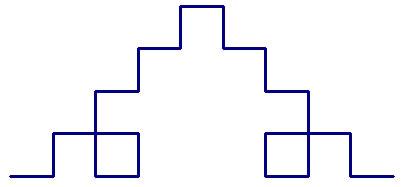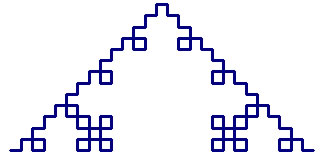| iteration 0 | |
| iteration 1 | |
| iteration 2 | |
| new: iteration 3 |
Total length of fractals answers:
1. This fractal rule for the fractal Cantor dust is: take out the middle third or each segment in the previous iteration.
A. Draw the next iteration of the fractal
iteration 0 iteration 1 iteration 2 new: iteration 3
B. Complete the table below, and explain your rule for finding the numbers that go in the table
iteration number number of pieces length of each piece total length 1 1 1 1 2 2 1/3 2/3 3 4 1/9 4/9 4 8 1/27 8/27 n 2n 1/3n 2n/3n ... this doubles each time because a single segment is traded for two smaller segments.
after n iterations, you have 2 times itself n times = 2n
the denominator is multiplied by 3 each time OR the length is multiplied by 1/3 each time because when you remove the middle third, the segments left are each 1/3 as long as the previous segment
after n iterations, the denominator is 3 times itself n times = 3n
multiply the number of pieces by the length of each piece to get the total length.
2. The fractal rule for this fractal (this one doesn't have a name) is: take out the middle third, and replace it with the top 3/4 of a square:
Segment was: |
Changed to: |
 |
This one's a little hard to visualize, so I have color coded a version to help you see the change from iteration 1 to iteration 2:
Iteration 1 is: |
Iteration 2 is: |
 |
 |
A. Draw iteration 3
| iteration 0 | |
| iteration 1 |  |
| iteration 2 |  |
| iteration 3 |  |
B. Complete the table below, and explain your rule for finding the numbers that go in the table
| iteration number | number of pieces | length of each piece | total length |
| 0 | 1 | 1 | 1 |
| 1 | 5 | 1/3 | 5/3 |
| 2 | 25 | 1/9 | 25/9 |
| 3 | 125 | 1/27 | 125/27 |
| n | 5n | 1/3n | 5n/3n |
| ... | this multiplies by 5 each time because a single segment is traded for 5 smaller segments. after n iterations, you have 5 times itself n times = 5n |
the denominator is multiplied by 3 each time OR the length is multiplied by 1/3 each time because when you remove the middle third, the segments left are each 1/3 as long as the previous segment after n iterations, the denominator is 3 times itself n times = 3n |
multiply the number of pieces by the length of each piece to get the total length. |